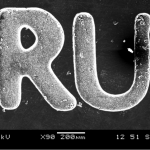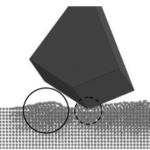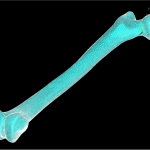Modeling of Abrasive Jet Micro-machining
Abrasive jet, abrasive waterjet, and abrasive slurry jet micro-machining are non-traditional micro-fabrication technologies that utilize high speed jets of microscopic particles to mechanically etch a wide variety of materials without generating heat or otherwise affecting material properties. Since they are of relatively low cost, are environmentally friendly, and have a unique anisotropic etch capability, they show promise for the fabrication of the next generation of 3D components used in MEMS, microfluidics, and micro-fuel cell devices. We specialize in developing analytical, numerical, and simulation based process models that allow us to predict the size and shape of features micro-machined using these technologies, as a function of process parameters such as particle size, shape, velocity, etc.
Modeling of Solid Particle Erosion Mechanisms and Particle Embedment
When a surface is subject to repeated impacts by small abrasive particles, the damage and subsequent material removal that occurs is known as solid particle erosion. Such damage can be thought of as constructive, such as in abrasive jet machining or blast cleaning operations, or as in destructive, such as in the damage to turbo machinery or gas pipelines that occurs due to gas-borne particulates. Despite over 60 years of research, important questions remain regarding the fundamental mechanisms of solid particle erosion, and the effect that particle size, shape, velocity, target material properties, degree of particle embedment, etc. have on the resulting erosion rate. To answer some of these questions, we use numerical models of single and multiple overlapping impacts of realistic angular particles to allow us to ‘slow down’ the impacts so that the fundamental material removal mechanisms can be better understood.
Modeling in Orthopaedic Biomechanics
Our research in this area has focused on the use of artificial composite bone analogues in conjunction with finite element analyses for evaluating the performance of orthopaedic implants. We have created a 3D model of the 3rd Generation Composite Femur from Pacific Research Laboratories with full muscle attachment data, and made it available for public download and use for research purposes. We have created and experimentally validated models of intramedullary nails, fracture fixation plates, and several hip implants attached to the composite bones. We have also utilized analogue bones to determine the factors that are most important to the pressure build-up in the intramedullary canal of bones during orthopaedic procedures, leading to fat embolus syndrome. Most recently, our research has focused on modeling of engineered articular cartilage using finite element analyses coupled to optimization algorithms.



